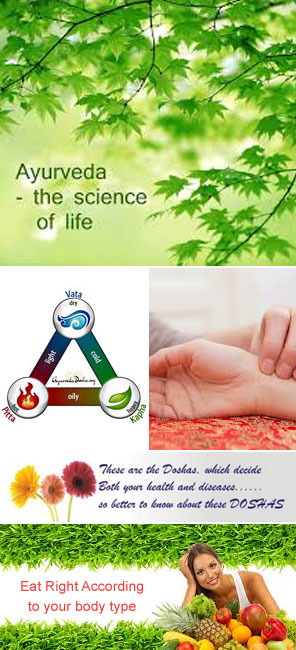

About Ayurveda
Ayurveda is the ancient Indian medical science originated in India some 6500 years ago. Ayurveda is the only ancient independent scientific system of medicines.
Ayurveda is not a mere medical science but a life science.
Ayur - life, the unified state of body, mind and soul.
Veda – Science (Knowledge)
It is a holistic system with equal emphasis on the body, mind and soul. Ayurveda is a science dealing not only with treatment of diseases but is a complete way of life. Ayurveda aims at making a happy, healthy and peaceful society.
Ayurveda is based on three energies-
Vata - The kinetic energy, movement- therefore can be seen as the force which directs nerve impulses, division, respiration, circulation, elimination etc.
Pitta - The thermal energy, metabolism, heat generation, intellect, sight etc.
Kapha - The potential energy, growth, adding structure unit by unit, it also offers protection for example in form of cerebrospinal fluid which protects brain and spinal Column, mucosal lining of the stomach, synovial fluid of joints, etc.
Other important basic elements are-
Dhatus – These are the basic tissues which maintain and nourish the body. They are seven in number, namely – Rasa (chyle), Rakta (blood), Mansa (muscles), Meda (fatty tissues), Asthi ( bone ), Majja ( marrow) and Sukra ( semen). Proper amount of each dhatu and its balanced function is very important for good health.
Mala – These are the waste materials produced as a result of various metabolic activities in the body. They are mainly Mutra (urine), Mala ( feces), Sweda ( sweat), etc. Proper elimination of the malas is equally important for good health. Accumulation of malas cause many diseases in the body.
Srotas – These are different types of channels which are responsible for transportation of food, dhatus, malas and doshas. Lack of proper function of srotas cause many diseases.
Agni – These are different types of enzymes responsible for digestion and transforming one material to other.
Healing is to try to maintain balance between tri doshas vata, pitta and kapha.
We not only treat diseases but emphasize on preventing disease and enhancing health, longevity, vitality and happiness.
All these factors need to function in a proper balance for good health. They are inter-related and are directly or indirectly responsible for maintaining equilibrium of the TRIDOSHA.
Their balanced state is health and imbalance is disease.
Prakriti or body constitution-
Prakriti means your innate nature and basic constitution. The physical and emotional qualities that you inherit genetically. In Ayurveda prakriti diagnosis is very important in disease diagnosis and treatments. Prakriti is described by three main doshas i.e. Vata, Pitta and Kapha. In Ayurveda doshas influence the well –being and physical constitution of a man, either positively or negatively. According to Ayurveda , there are seven dosha-predominant Prakritis namely- Vata predominant, Pitta predominant, Kapha predominant, Vatta-Pitta predominant, Pitta –Kapha predominant, Vata- Kapha predominant.
Vata-Pitta-Kapha predominant (in this Prakriti all three doshas are equally prominent).
Who is healthy?
According to Ayurveda- whose doshas are in balance, appetite is good, all tissues of the body and all urges are functioning properly, and whose mind, body and spirit are cheerful.
Objective of Ayurveda
Preventive care to preserve health
Therapeutic means to treat diseases.
Thus Ayurveda is a combination of preventive health care , healing, and philosophy of living.


Connect with us:-